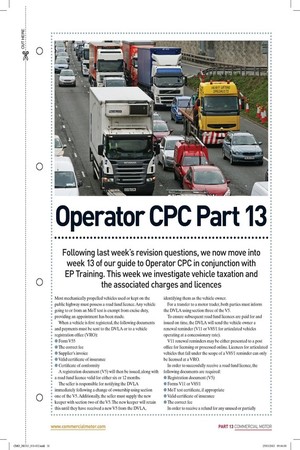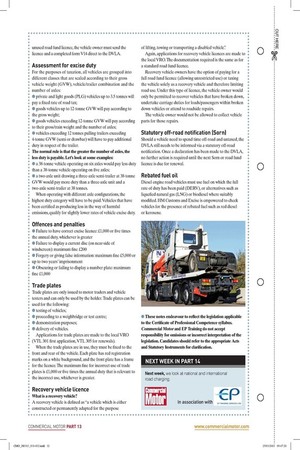Operator CPC Part 13 Following last week's revision questions, we
Page 19

Page 20

If you've noticed an error in this article please click here to report it so we can fix it.
now move into week 13 of our guide to Operator CPC in conjunction with EP Training. This week we investigate vehicle taxation and the associated charges and licences Most mechanically propelled vehicles used or kept on the public highway must possess a road fund licence. Any vehicle going to or from an MoT test is exempt from excise duty, providing an appointment has been made.
When a vehicle is first registered, the following documents and payments must be sent to the DVLA or to a vehicle registration office (VRO): • Form V55 • The correct fee • Supplier's invoice • Valid certificate of insurance • Certificate of conformity A registration document (V5) will then be issued, along with a road fund licence valid for either six or 12 months.
The seller is responsible for notifying the DVLA immediately following a change of ownership using section one of the V5. Additionally, the seller must supply the new keeper with section two of the V5. The new keeper will retain this until they have received a new V5 from the DVLA, identifying them as the vehicle owner.
For a transfer to a motor trader, both parties must inform the DVLA using section three of the V5.
To ensure subsequent road fund licences are paid for and issued on time, the DVLA will send the vehicle owner a renewal reminder (V11 or V85/1 for articulated vehicles operating at a concessionary rate).
V11 renewal reminders may be either presented to a post office for licensing or processed online. Licences for articulated vehicles that fall under the scope of a V85/1 reminder can only be licensed at a VRO.
In order to successfully receive a road fund licence, the following documents are required: • Registration document (V5) • Forms V11 or V85/1 • MoT test certificate, if appropriate • Valid certificate of insurance • The correct fee In order to receive a refund for any unused or partially unused road fund licence, the vehicle owner must send the licence and a completed form V14 direct to the DVLA.
Assessment for excise duty For the purposes of taxation, all vehicles are grouped into different classes that are scaled according to their gross vehicle weight (GVVV), vehicle/trailer combination and the number of axles: • private and light goods (PLG) vehicles up to 3.5 tonnes will pay a fixed rate of road tax; • goods vehicles up to 12-tonne GVVV will pay according to the gross weight; • goods vehicles exceeding 12-tonne GVVV will pay according to their gross/train weight and the number of axles; • vehicles exceeding 12 tonnes pulling trailers exceeding 4-tonne GVVV (semi or drawbar) will have to pay additional duty in respect of the trailer.
The normal rule is that the greater the number of axles, the less duty is payable. Let's look at some examples: • a 38-tonne vehicle operating on six axles would pay less duty than a 38-tonne vehicle operating on five axles; • a two-axle unit drawing a three-axle semi-trailer at 38-tonne GVVV would pay more duty than a three-axle unit and a two-axle semi-trailer at 38 tonnes.
When operating with different axle configurations, the highest duty category will have to be paid. Vehicles that have been certified as producing less in the way of harmful emissions, qualify for slightly lower rates of vehicle excise duty.
Offences and penalties • Failure to have correct excise licence: £1,000 or five times the annual duty, whichever is greater • Failure to display a current disc (on near-side of windscreen): maximum fine £200 • Forgery or giving false information: maximum fine £5,000 or up to two years' imprisonment • Obscuring or failing to display a number plate: maximum fine £1,000 Trade plates Trade plates are only issued to motor traders and vehicle testers and can only be used by the holder. Trade plates can be used for the following: • testing of vehicles; • proceeding to a weighbridge or test centre; • demonstration purposes; • delivery of vehicles.
Applications for trade plates are made to the local VRO (VTL 301 first application,VTL 305 for renewals).
When the trade plates are in use, they must be fixed to the front and rear of the vehicle. Each plate has red registration marks on a white background, and the front plate has a frame for the licence. The maximum fine for incorrect use of trade plates is £1,000 or five times the annual duty that is relevant to the incorrect use, whichever is greater.
Recovery vehicle licence What is a recovery vehicle?
A recovery vehicle is defined as "a vehicle which is either constructed or permanently adapted for the purpose of lifting, towing or transporting a disabled vehicle': Again, applications for recovery vehicle licences are made to the local VRO. The documentation required is the same as for a standard road fund licence.
Recovery vehicle owners have the option of paying for a full road fund licence (allowing unrestricted use) or taxing the vehicle solely as a recovery vehicle and therefore limiting road use. Under this type of licence, the vehicle owner would only be permitted to recover vehicles that have broken down, undertake carriage duties for loads/passengers within broken down vehicles or attend to roadside repairs.
The vehicle owner would not be allowed to collect vehicle parts for those repairs.
Statutory off-road notification (Sorn) Should a vehicle need to spend time off-road and untaxed, the DVLA still needs to be informed via a statutory off-road notification. Once a declaration has been made to the DVLA, no further action is required until the next Sorn or road fund licence is due for renewal.
Rebated fuel oil Diesel engine road vehicles must use fuel on which the full rate of duty has been paid (DERV), or alternatives such as liquefied natural gas (LNG) or biodiesel where suitably modified. HM Customs and Excise is empowered to check vehicles for the presence of rebated fuel such as red diesel or kerosene.









































